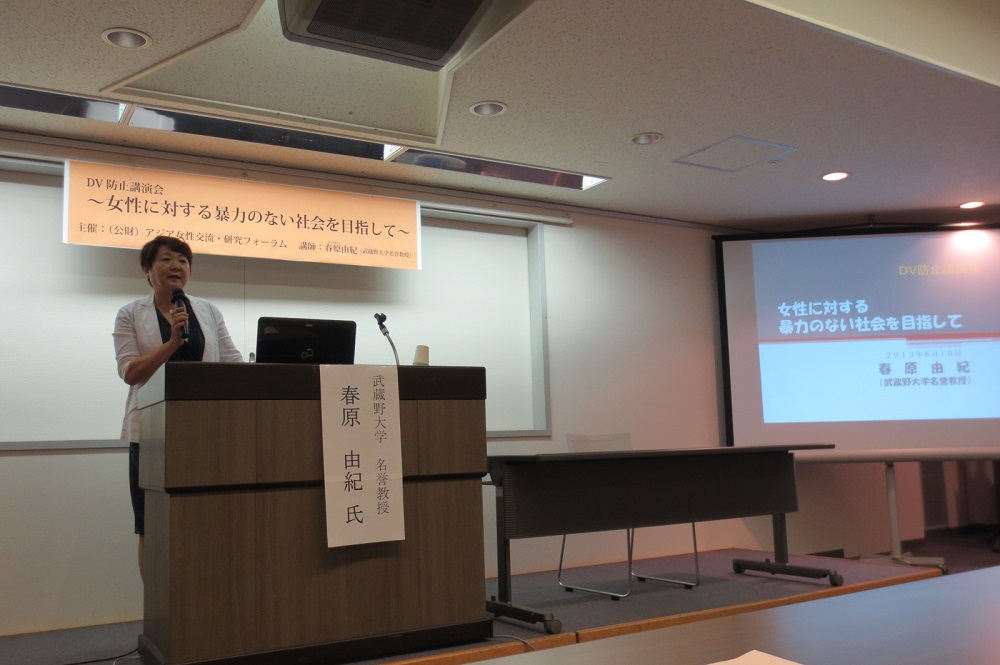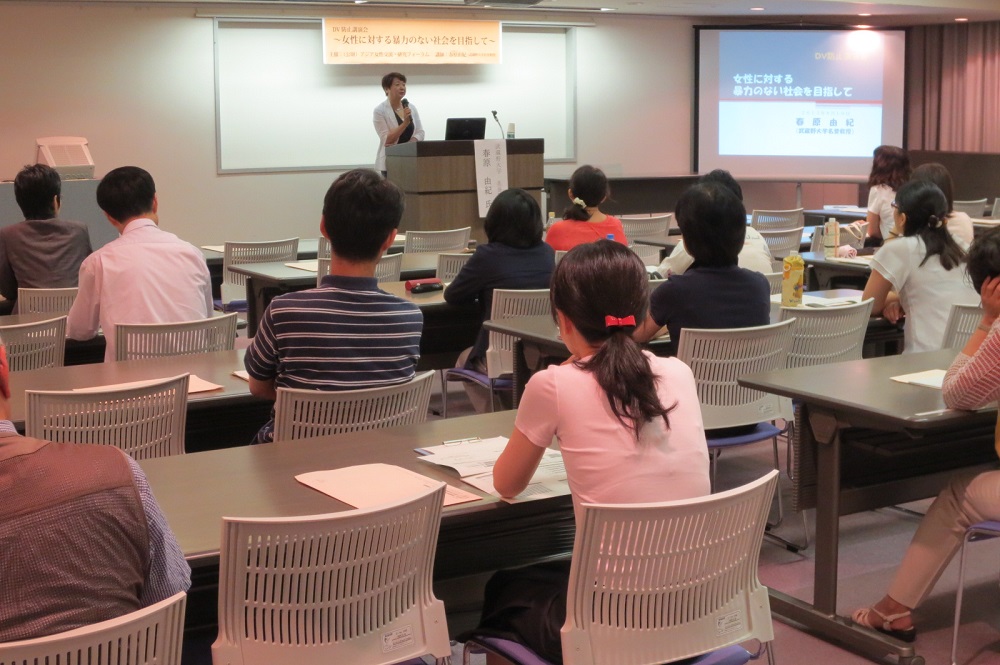| 1.Date | August 10, 2013 |
| 2.Lecturer | Yuki Sunohara, Professor Emeritus, Musashino University |
| 3.Participants | 40 |
Professor Emeritus Yuki Sunohara of Musashino University delivered a lecture titled “DV Prevention Seminar: Toward a Society without Violence against Women.”
Using data released by the Cabinet Office of the government of Japan regarding violence by spouses, she first explained about the current and actual situation concerning violence against women. According to a survey in Japan, approximately one in four persons has suffered DV from their spouses, and the majority of the victims are women.

Apart from affecting victims physically and visibly, DV also causes chronic disorders, such as post-traumatic stress disorder (PTSD), depression, dissociative disorder, low self-esteem, impaired judgment and decision-making abilities, and social isolation. Of particular note is PTSD, which continues to torment victims for a long period of time even after they have escaped from their abusers. This disorder is particularly characterized by the following symptoms: intrusion (a feeling that a past DV experience were now occurring); avoidance (overreacting to small, daily events due to a past DV experience); and hyper-arousal (staying aroused and suffering nightmares or insomnia).

■Suffering DV
Violence is used to control others’ actions. This means that violence serves as a tool for the abuser to control the victim as they wish. Consequently, the victim stops thinking on their own due to the fear, which deprives the victim of their independence. In the Japanese social system and culture, which justify such control, the abuser recognizes violence as an “unquestioned truth.” As there was in the prewar Japan, there still exists a social culture in Japan where violence is regarded as unavoidable for maintaining order.
Subsequently, Professor Sunohara explained the ABC model used in cognitive behavioral therapy. The theory is that an Activating event triggers a particular series of Beliefs. These beliefs trigger emotional and behavioral responses (Consequences). Suppose that a room of a couple is messy. The husband might think “She doesn’t understand how tired I am,” “Men must be respected,” and “It’s the wife’s role to take care of household chores.” On the other hand, the husband might think “She must be busy taking care of our kids,” and “I can’t leave our household chores always to her.” Which option the husband will select considerably affects his subsequent action. The former option can lead to DV, which occurs as a result of the abuser having selected the former option. This means that a change in beliefs (thoughts) will generate an emotional change and lead to the selection of non-violent behavior.
Professor Sunohara indicated that the problem also resided in the fact that many people believe that responsibility for DV can be shared between the abuser and the victim. In other words, they think that since the victim must have done something wrong and she was to be blamed as well, the violence was unavoidable. However, Professor Sunohara said full responsibility for a wife’s action lies with the wife, and full responsibility for a husband’s action lies with the husband. Therefore, full responsibility for violence resides in the abuser.
■Influence on Children Growing up Witnessing DV
Following the revision of the Child Abuse Prevention Law, letting children witness DV has been positioned as a form of child abuse. Children growing up witnessing DV display the same symptoms as children directly suffering abuse themselves. Professor Sunohara said that few children growing up in such a severe situation can digest their difficult experience, which often leads to an inter-generational chain of abuse. The influence on the behavior of children growing up in DV situations includes violent actions, high aggression, development disorders, lack of attention, and hyperactivity disorder. The influence on their emotions includes self-reproach, guilt, a sense of helplessness, a sense of uneasiness, a feeling of tension, and a sense of isolation. Moreover, the influence on their values includes the justification of violence, and incorrect ideas, such as men are superior to women, there is love behind control, and the strong can control the weak.
■Toward Support for Recovery and Independence
A wide variety of difficulties concerning DV damage are very often observed after victims are placed in a safe situation away from their abusers. Professor Sunohara concluded her lecture indicating that since a diverse and complex range of support measures were required for the victims to recover, it is crucial to provide not temporary support, but long-term, continuing support.


